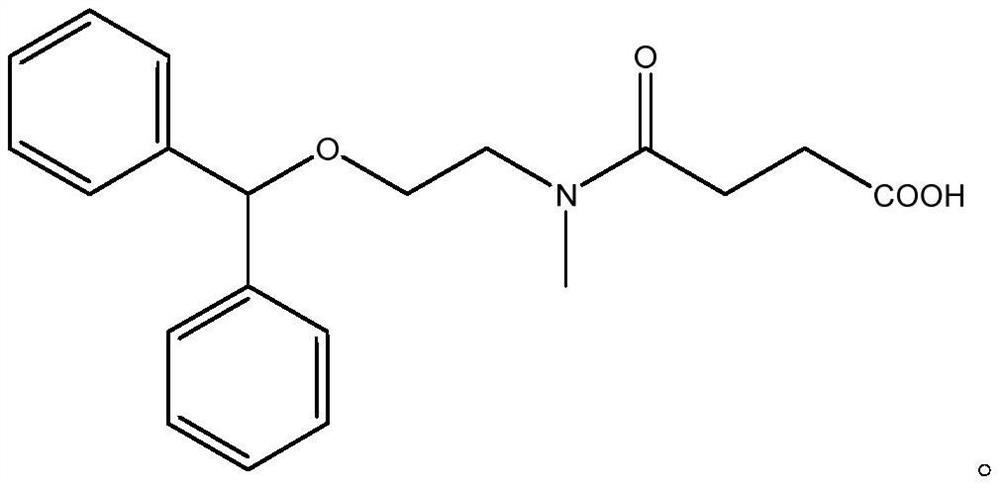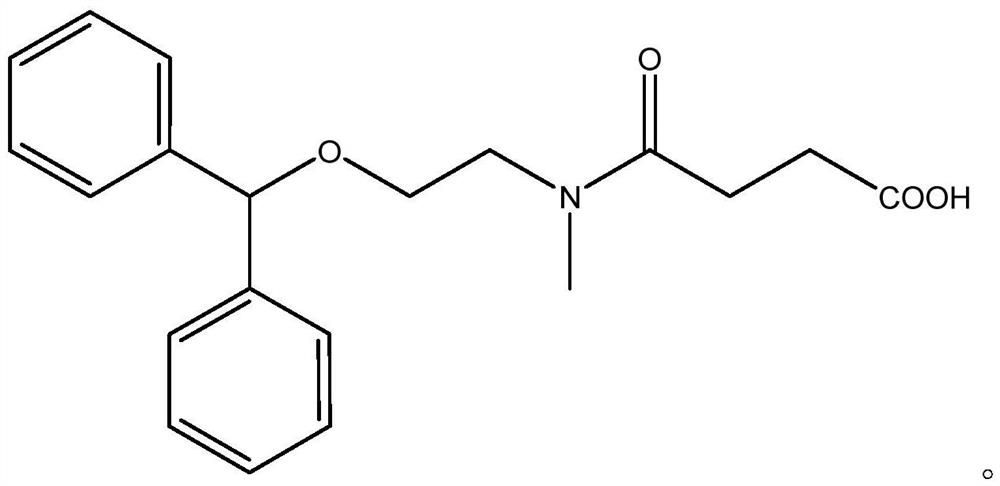Hybridoma cell lines secreting diphenhydramine monoclonal antibodies and application thereof
A hybridoma cell line and monoclonal antibody technology, which is applied in the direction of analytical materials, microbial-based methods, preparation of organic compounds, etc., can solve the problems of high solvent, consumption, expensive equipment, etc., and achieve the effect of good detection sensitivity
- Summary
- Abstract
- Description
- Claims
- Application Information
AI Technical Summary
Problems solved by technology
Method used
Image
Examples
Embodiment 1
[0047] Example 1: Synthesis of diphenhydramine hapten
[0048] Since the diphenhydramine small molecule is not immunogenic, it cannot stimulate the mice to produce an immune response and then produce antibodies, so it is necessary to couple diphenhydramine to the protein through protein linkage technology to make it immunogenic; protein Active groups commonly used in coupling technology include amino, carboxyl, hydroxyl, mercapto, etc. Since diphenhydramine’s molecular structure does not contain these active groups, it needs to be derivatized. The specific steps are as follows:
[0049] Weigh 50 mg of 2-(benzhydryloxy)-N-methylethylamine, dissolve it in 5 mL of pyridine, then add 25 mg of succinic anhydride to the reaction solution, stir the reaction at 50°C for 4 h, then add 10 mL of ultrapure Water quenches the reaction to give the derivative product. Then use chloroform to extract three times, combine the chloroform phase and blow with nitrogen to obtain the diphenhydramin...
Embodiment 2
[0050] Example 2: Synthesis of Diphenhydramine Immunogen
[0051] Weigh 5.5 mg diphenhydramine hapten, 4.2 mg N-hydroxysuccinimide (NHS), dissolve in 300 μL N,N-dimethylformamide (DMF), stir at room temperature for 10 min to obtain diphenhydramine Ming hapten solution; then weighed 6.9mg 1-(3-dimethylaminopropyl)-3-ethylcarbodiimide hydrochloride (EDC), fully dissolved with 100μL DMF, added to diphenhydramine In the hapten solution, stir at room temperature for 6-8h (referred to as liquid A). Take 8 mg of BSA, dilute it to 4 mg / mL with 0.01M carbonate buffer (CBS) (referred to as solution B), then slowly add solution A to solution B drop by drop, react at room temperature overnight; then use 0.01M PBS solution Dialyzed to remove unreacted small molecular haptens, to obtain the diphenhydramine immunogen, which was identified by ultraviolet absorption scanning method.
Embodiment 3
[0052] Embodiment 3: the synthesis of diphenhydramine coating former
[0053] Dissolve 3.0 mg of diphenhydramine hapten and 2.3 mg of N-hydroxysuccinimide (NHS) in 300 μL of anhydrous N,N-dimethylformamide (DMF), and stir at room temperature for 10 minutes to obtain diphenhydramine Hapten solution; 3.8 mg of 1-(3-dimethylaminopropyl)-3-ethylcarbodiimide hydrochloride (EDC) was dissolved in 100 μL of anhydrous DMF, and added to diphenhydramine hapten solution , stirred at room temperature and reacted for 6-8 hours to obtain liquid A; dilute 10 mg of chicken ovalbumin (OVA) with 1 mL of carbonate buffer solution (CBS) with a concentration of 0.01 mmol / L to obtain liquid B; The solution was slowly added into solution B for reaction to obtain a reaction solution; the reaction solution was dialyzed with PBS solution to remove unreacted small molecule haptens to obtain the coating original.
PUM
| Property | Measurement | Unit |
|---|---|---|
| Sensitivity | aaaaa | aaaaa |
Abstract
Description
Claims
Application Information
 Login to View More
Login to View More - R&D
- Intellectual Property
- Life Sciences
- Materials
- Tech Scout
- Unparalleled Data Quality
- Higher Quality Content
- 60% Fewer Hallucinations
Browse by: Latest US Patents, China's latest patents, Technical Efficacy Thesaurus, Application Domain, Technology Topic, Popular Technical Reports.
© 2025 PatSnap. All rights reserved.Legal|Privacy policy|Modern Slavery Act Transparency Statement|Sitemap|About US| Contact US: help@patsnap.com



